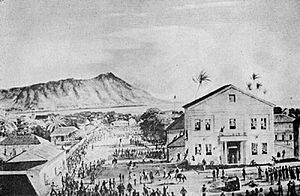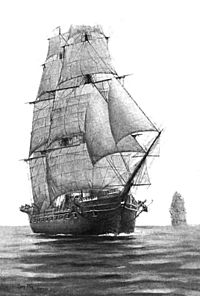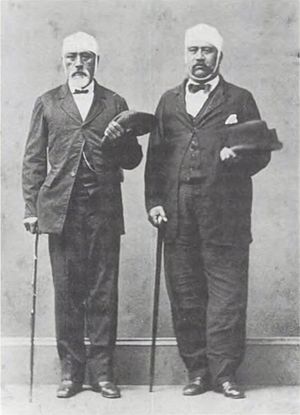Honolulu Courthouse riot facts for kids
Quick facts for kids Honolulu Courthouse riot |
|||||||
|---|---|---|---|---|---|---|---|
 "The Election Riot of 1874", by Peter Hurd. |
|||||||
|
|||||||
| Belligerents | |||||||
| Commanders and leaders | |||||||
| Hulu (riot leader) | |||||||
| Strength | |||||||
| Land: ~225 Sea: 3 sloops-of-war |
~100 | ||||||
- This riot should not be confused with the 1852 Whaler Riot in Honolulu.
The Honolulu Courthouse riot, also called the Election riot, happened in February 1874. It was a big event in Hawaii when supporters of Queen Emma attacked followers of King Kalakaua. This happened on the day Kalakaua was elected king. Soldiers and sailors from American and British ships helped stop the riot. King Kalakaua then officially became king the next day without any more trouble.
Contents
The Royal Election of 1874
The Royal Election of 1874 took place in Hawaii on February 12, 1874. This was only the second time an election was held for the head of state in Hawaii. The Constitution of 1864 said that if a ruler died without naming a successor, the Legislative Assembly would choose the next leader. This meant that representatives, not the public, voted for the new king or queen.
Who Ran for King?
Three main people were considered for the role of king or queen:
- David Kalākaua
- Emma Rooke (Queen Emma)
- Bernice Bishop
The Riot Begins
After King Lunalilo passed away on February 3, 1874, a new election was needed. Queen Emma, who was the widow of a previous king, ran against David Kalakaua. Many people in Honolulu liked Queen Emma. However, the Hawaiian legislature, which was mostly pro-American, preferred Kalakaua. He was seen as more open to the growing American business interests in the islands.
On election day, February 12, Queen Emma lost the vote in the legislature. Kalakaua won by a vote of thirty-nine to six. Queen Emma's supporters were very upset by this decision. About 100 of them gathered outside the Honolulu Courthouse, where the election was held.
Hawaii's army had been disbanded earlier, and the local militias were not reliable. So, there was no one to stop the angry crowd. Even the Honolulu police force joined the unrest, with some officers fighting each other based on their political views.
The queen's followers surrounded the courthouse around 3:00 AM. Then, the riot spread to other buildings across the city. A carriage was waiting to take the election news to Kalakaua, but the mob destroyed it before the news could be delivered.
Kalakaua's supporters offered little resistance. Officials decided to ask for help from the American Minister, Henry A. Peirce. He requested aid from the United States Navy and the Royal Navy ships nearby.
Two American ships, USS Tuscarora and USS Portsmouth, were in Honolulu Harbor. They were there to discuss a trade agreement. Instead, their commanders agreed to help stop the riot.
Stopping the Riot
A group of 150 American marines and sailors, led by Lieutenant Commander Theodore F. Jewell, came ashore. About 70 to 80 British soldiers, led by Captain Edward Hood Lingard Ray from the ship HMS Tenedos, also landed.
The American forces went straight to the courthouse. They pushed back the rioters and set up guards. They also took control of the city armory, the treasury, the police station, and the jail. The jail was full of angry prisoners whom Queen Emma had supposedly promised to free.
British forces went up the Nuuanu Valley to Queen Emma's house. They broke up a large crowd there. Then, they returned to Honolulu to guard the palace and the barracks. By sundown, some rioters had been captured, and the city was mostly calm. There were still some gunshots and sounds of breaking glass.
Several people were hurt or killed during the riot. Many foreign citizens were injured, but no American or British naval personnel were seriously harmed. Queen Emma said she had no part in the riot, but many believed she supported her followers' actions.
The riot did not help Queen Emma's cause. King Kalakaua officially took his oath on February 13. After that, his right to the throne was secure. The marines and sailors left Honolulu on February 20. America's involvement in the riot also led to the first United States Navy coaling and repair station being set up in Pearl Harbor.
Injuries and Casualties
Many people were injured during the riot. Thirteen legislators who voted for Kalākaua were badly hurt. These included Samuel Kipi, J. W. Lonoaea, Thomas N. Birch, David Hopeni Nahinu, P. Haupu, C. K. Kakani, S. K. Kupihea, William Luther Moehonua, C. K. Kapule, D. Kaukaha, Pius F. Koakanu, D. W. Kaiue and R. P. Kuikahi. Pictures from the time suggest that William Thomas Martin might also have been injured.
Two people not connected to the legislature were also hurt. One was a British man named John Foley, who tried to save Moehonua from the rioters. The other was a Hawaiian supporter of Kalākaua named John Koii Unauna. No other foreigners were harmed besides Foley. Sadly, Representative Lonoaea was the only person who died from his injuries during the event.
See also
- Pacific Squadron
- Battle of Nuuanu
- Kepelino



